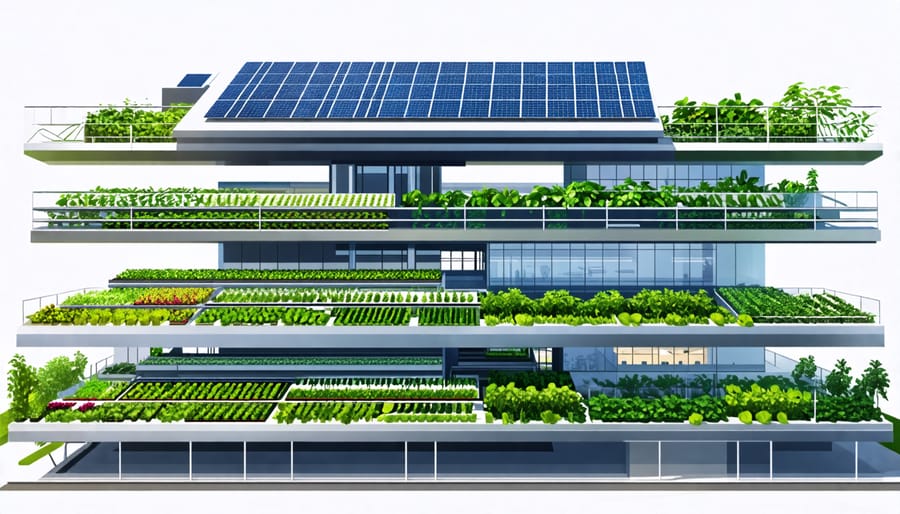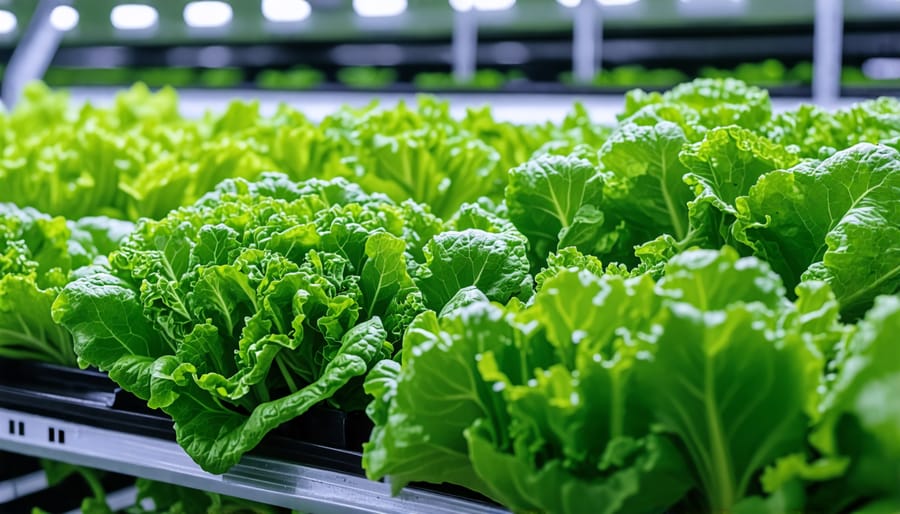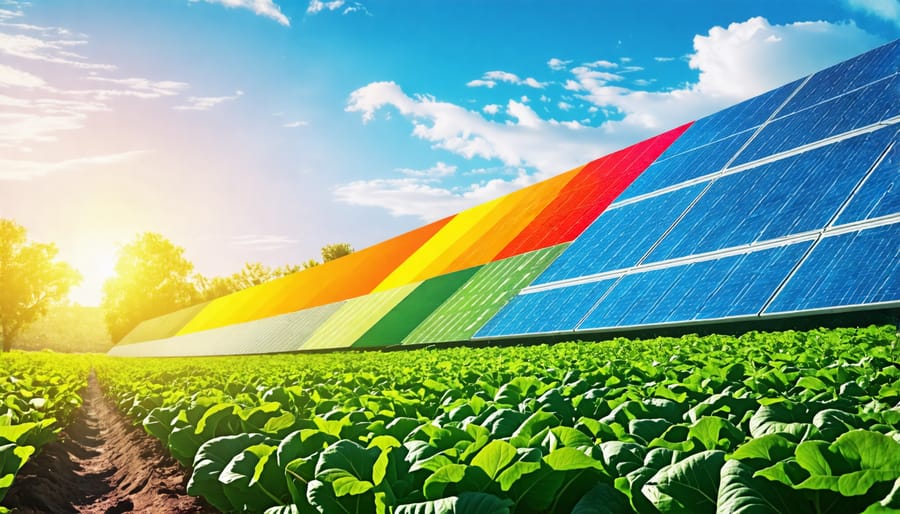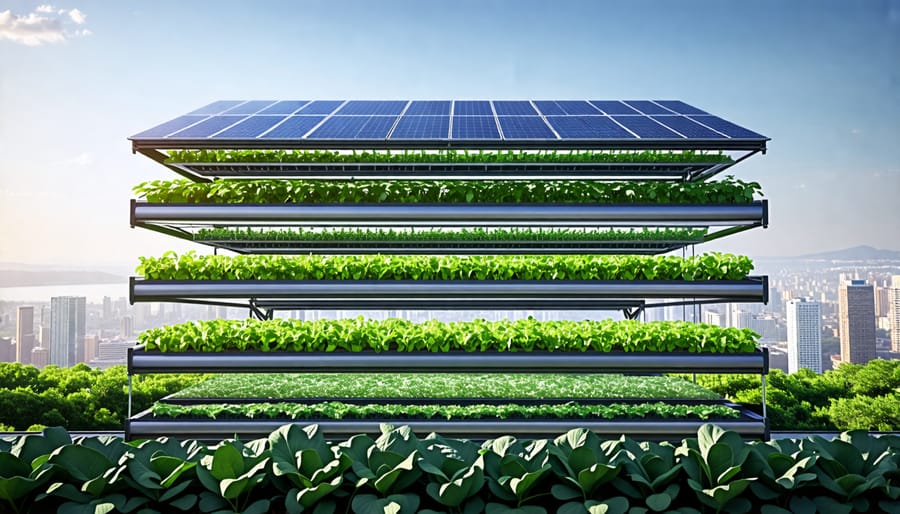Discover the groundbreaking potential of vertical agrivoltaics—a revolutionary approach to sustainable agriculture that combines vertical farming with solar energy production. This innovative technology offers a promising solution to the pressing challenges of food security, land scarcity, and climate change. By integrating photovoltaic panels with vertical farming systems, vertical agrivoltaics enables the simultaneous cultivation of crops and generation of renewable energy, optimizing land use efficiency and reducing the environmental footprint of agriculture. As researchers and innovators continue to refine and scale up this cutting-edge approach, vertical agrivoltaics holds the key to transforming the way we grow food and power our world, paving the way for a more sustainable and resilient future.
How Vertical Agrivoltaics Works

Vertical Farming
Vertical farming is a revolutionary approach to agriculture that involves growing crops in vertically stacked layers within a controlled indoor environment. This innovative technique enables efficient use of space and resources, making it an attractive solution for urban areas with limited land availability. By utilizing artificial lighting, hydroponic or aeroponic systems, and precise control over temperature, humidity, and nutrients, vertical farms can optimize plant growth while minimizing water usage and eliminating the need for pesticides.
One of the key benefits of vertical farming is its ability to produce high yields year-round, regardless of external weather conditions. This consistency in production ensures a reliable supply of fresh, locally grown produce for communities. Additionally, the enclosed environment of vertical farms protects crops from pests, diseases, and extreme weather events, reducing crop losses and improving food security.
Vertical farming also offers environmental advantages by reducing the carbon footprint associated with traditional agriculture. By locating farms closer to urban centers, transportation costs and emissions are minimized. Furthermore, the closed-loop systems employed in vertical farms allow for the recycling of water and nutrients, promoting sustainable resource management.
As the world’s population continues to grow and urbanize, vertical farming presents a promising solution to meet the increasing demand for fresh, sustainably produced food. With its efficient use of space and resources, vertical farming is poised to play a crucial role in the future of agriculture and sustainable food production.

Solar Energy Integration
In vertical agrivoltaic systems, solar panels are seamlessly integrated into the vertical farming structure to harness the power of renewable energy. By strategically placing photovoltaic panels on the exterior of the building or greenhouse, these innovative systems capture solar energy while allowing optimal light transmission for plant growth. Advances in solar energy optics have enabled the development of semi-transparent and wavelength-selective panels that filter out specific light spectra for solar energy generation while transmitting the necessary wavelengths for photosynthesis.
The generated electricity from the solar panels can be used to power various aspects of the vertical farm, such as LED lighting, climate control systems, and automated irrigation. This integration of renewable energy reduces the overall carbon footprint of the farming operation and helps to offset the energy costs associated with indoor agriculture. Furthermore, the co-location of solar panels and crops creates a mutually beneficial relationship, as the plants can help to cool the panels and improve their efficiency. Regular maintaining solar panels ensures optimal performance and maximizes the energy generation potential of the vertical agrivoltaic system.

Benefits of Vertical Agrivoltaics
Increased Crop Yields
Vertical farming, a key component of vertical agrivoltaics, enables crops to be grown in stacked layers within a controlled environment. By utilizing vertical space, farmers can cultivate a larger number of plants in a smaller footprint compared to traditional horizontal farming. “Vertical farming can produce yields up to 10 times higher per square meter than conventional methods,” explains Dr. Liana Tran, a researcher at the Center for Sustainable Agriculture. This increased productivity is achieved through optimized growing conditions, such as precise control over light, temperature, humidity, and nutrients. Additionally, the enclosed nature of vertical farms protects crops from pests, diseases, and adverse weather conditions, further enhancing yields and reducing crop losses. As the world’s population continues to grow and arable land becomes scarce, vertical farming offers a promising solution to maximize food production while minimizing land use, making it a key advantage of vertical agrivoltaic systems.
Renewable Energy Generation
One of the key advantages of vertical agrivoltaics is the on-site generation of renewable energy to power the farm’s operations. By integrating solar panels into the vertical farming structure, a significant portion of the farm’s energy needs can be met sustainably. This not only reduces reliance on fossil fuels but also lowers operating costs in the long run. The solar energy produced can power LED lighting systems, climate control, and automation technologies crucial for optimizing plant growth in controlled environments. Moreover, any excess energy generated can be fed back into the grid, potentially providing an additional revenue stream for the farm. This decentralized approach to energy production enhances the resilience and self-sufficiency of vertical agrivoltaic systems, making them an attractive option for sustainable agriculture in urban and remote settings alike.
Water Conservation
Vertical agrivoltaics offers a promising solution for water conservation in agriculture. By integrating crops with solar panels, this innovative system creates a cooler, more humid microclimate that reduces evaporation and transpiration from plants. Research has shown that the shading provided by the panels can decrease crop water requirements by up to 30%. Furthermore, the collected solar energy can power efficient drip irrigation, precisely delivering water to plant roots and minimizing waste. Rainwater harvesting systems can also be incorporated, capturing and storing precipitation for later use. These synergistic elements of vertical agrivoltaics work together to optimize water use efficiency, alleviating pressure on limited freshwater resources. As climate change intensifies water scarcity in many regions, this technology offers a viable path forward for sustainable food production. By enabling farmers to grow more with less water, vertical agrivoltaics has the potential to revolutionize water conservation practices in agriculture.
Environmental Benefits
Vertical agrivoltaics offers numerous environmental benefits compared to traditional farming methods. By combining solar energy generation with crop cultivation, this innovative approach significantly reduces land use requirements. Instead of dedicating separate areas for solar panels and agriculture, vertical agrivoltaics allows for efficient utilization of vertical space. This means more food can be grown on less land, helping to preserve natural habitats and biodiversity. Moreover, the integration of renewable energy production lowers the carbon footprint associated with farming activities. Dr. Maria Gonzalez, a researcher at the Center for Sustainable Agriculture, explains, “Vertical agrivoltaics has the potential to revolutionize how we approach food production while minimizing our environmental impact.” By harnessing solar power, vertical agrivoltaic systems can reduce reliance on fossil fuels and contribute to a cleaner, more sustainable future for agriculture.
Real-World Applications and Case Studies
As vertical agrivoltaics gains traction, several pioneering projects have demonstrated its potential for sustainable food production. One notable example is the vertical farm at the University of California, Davis, where researchers have successfully grown crops like lettuce, kale, and herbs alongside solar panels. “By optimizing the spacing and orientation of the panels, we’ve been able to maximize both energy generation and crop yields,” explains Dr. Emily Sanderson, lead researcher on the project. “This proves that vertical agrivoltaics can be a viable solution for farms looking to enhance sustainability and profitability.”
In Germany, a collaboration between Fraunhofer ISE and local farmers has yielded impressive results. Their vertical agrivoltaic system, spanning over 1,000 square meters, has increased crop production by 15% while generating enough electricity to power nearby buildings. Farmer Johann Müller shares his experience: “Adopting vertical agrivoltaics has been a game-changer for our farm. We’re producing more food with less water and energy, and the additional income from solar power has provided a welcome financial buffer.”
Across the globe, similar success stories are emerging. In Japan, a vertical agrivoltaic greenhouse has boosted tomato yields by 20% and reduced water consumption by 30%. The project’s coordinator, Yuki Tanaka, emphasizes the technology’s potential: “As we face the challenges of climate change and population growth, vertical agrivoltaics offers a sustainable path forward for agriculture.”
These real-world applications demonstrate that vertical agrivoltaics is not just a theoretical concept but a practical solution for sustainable food production. As more farmers and researchers embrace this innovative approach, the benefits for both agriculture and the environment are likely to grow exponentially. With the right policies and investments, vertical agrivoltaics could play a crucial role in shaping the future of farming, ensuring food security while minimizing the ecological footprint of agriculture.
Future Outlook and Challenges
As vertical agrivoltaics gains traction, its potential for widespread adoption is promising. According to Dr. Akira Nagashima, a pioneer in the field, “Vertical agrivoltaics could revolutionize the way we approach agriculture, especially in urban and space-limited environments.” The technology’s ability to optimize land use, reduce water consumption, and harness renewable energy makes it an attractive solution for sustainable farming.
However, challenges remain in scaling up vertical agrivoltaic systems. Initial setup costs can be high, and the technology requires specialized knowledge for maintenance and operation. Additionally, not all crops are suitable for vertical farming, limiting the variety of produce that can be grown. Despite these hurdles, ongoing research and development efforts aim to improve the efficiency and cost-effectiveness of vertical agrivoltaics.
As more successful pilot projects emerge, such as the vertical agrivoltaic greenhouse in Japan that achieved a 20% increase in crop yields, the adoption of this technology is likely to accelerate. Governments and organizations are recognizing the potential of vertical agrivoltaics in addressing food security and sustainability challenges, leading to increased funding and support for research and implementation. With continued advancements and collaboration between researchers, farmers, and policymakers, vertical agrivoltaics has the potential to become a key component of the future of agriculture.

